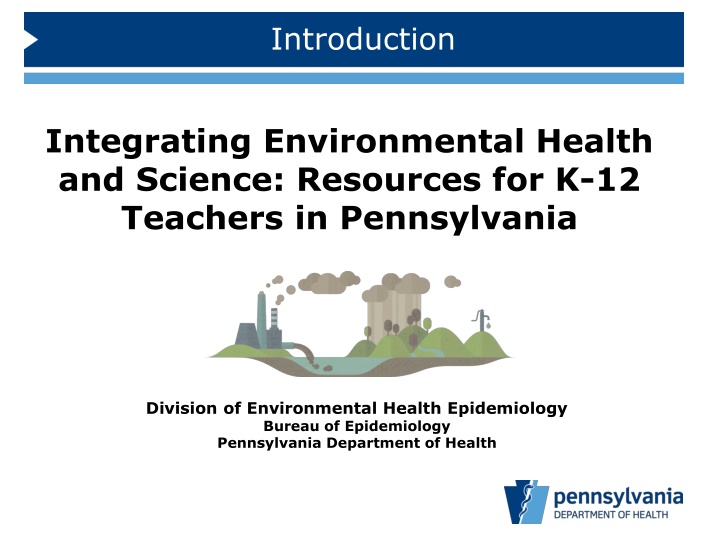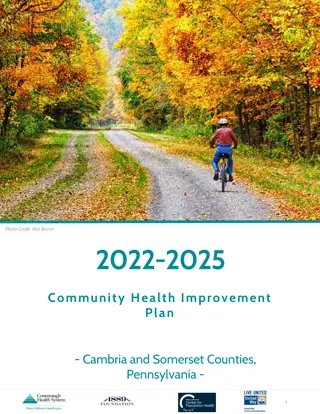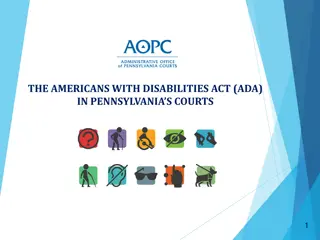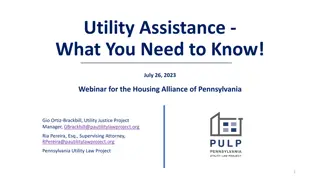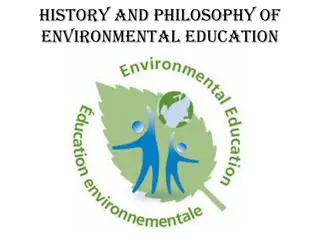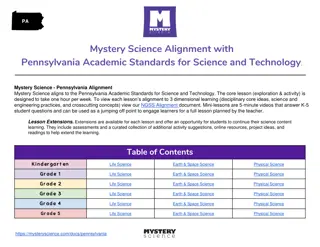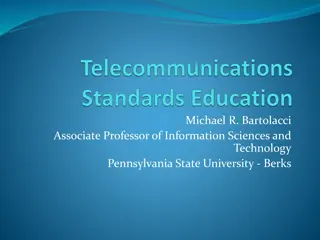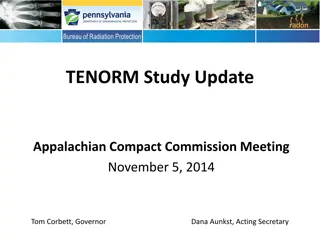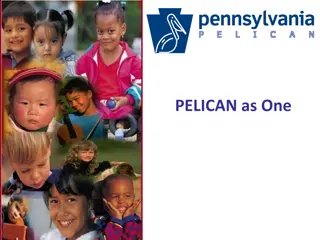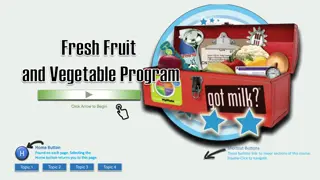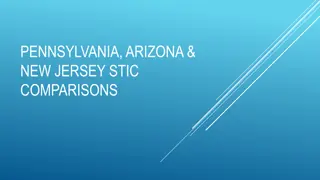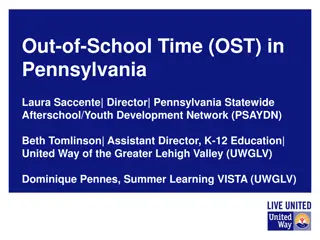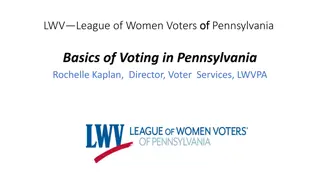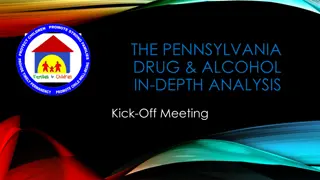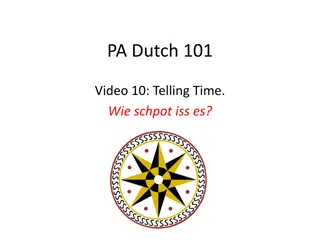Integrating Environmental Health Education for K-12 Teachers in Pennsylvania
Focusing on resources and information to support K-12 educators in effectively teaching environmental health and air quality education aligned with Pennsylvania's STEELS Standards. Explore key concepts, pedagogical strategies, curriculum development, lesson plans, interdisciplinary connections, and assessment methods.
Download Presentation

Please find below an Image/Link to download the presentation.
The content on the website is provided AS IS for your information and personal use only. It may not be sold, licensed, or shared on other websites without obtaining consent from the author.If you encounter any issues during the download, it is possible that the publisher has removed the file from their server.
You are allowed to download the files provided on this website for personal or commercial use, subject to the condition that they are used lawfully. All files are the property of their respective owners.
The content on the website is provided AS IS for your information and personal use only. It may not be sold, licensed, or shared on other websites without obtaining consent from the author.
E N D
Presentation Transcript
Introduction Integrating Environmental Health and Science: Resources for K-12 Teachers in Pennsylvania Division of Environmental Health Epidemiology Bureau of Epidemiology Pennsylvania Department of Health
Objective Identify information and resources available to K-12 educators for effectively teaching environmental health and air quality education in alignment with the Pennsylvania Department of Education's Science, Technology, and Engineering Environmental Literacy and Sustainability (STEELS) Standards. Standards and
Content Overview 1. Introduction: Understanding the Standards Overview of Pennsylvania s STEELS Standards 2. Importance of Environmental Health Education Emphasizing the value of integrating environmental health 3. Key Concepts in Environmental Health Exploring fundamental concepts Identifying real-world (Pennsylvania) examples and case studies 4. Pedagogical Approaches and Strategies Teaching strategies for environmental health 5. Lesson Plan Development Review of lesson plan development process guided by the Pennsylvania STEELS 6. Environmental Health Curriculum Highlighting STEELS-aligned environmental health curriculum 7. Sample Lesson Plans Highlighting suggested lesson plans
Content Overview (continued) 8. Interdisciplinary Connections Identifying opportunities to integrate environmental health and science across other subjects 9. Adapting Curriculum for Diverse Learners Addressing the needs of diverse learners 10. Assessment and Evaluation Strategies for assessing students understanding of environmental health and science concepts 11. Air Quality Education Resources Air quality resources including AirNow, Environmental Protection Agency (EPA) and the University Corporation for Atmospheric Research (UCAR) 12. Additional Education Resources Showcasing additional air quality resources. Availability of an air quality resource guide for teachers created by the Department of Health (DOH)
Introduction: Understanding the Standards Pennsylvania s Science, Technology and Engineering, Environmental Literacy and Sustainability (STEELS) Standards: Focuses on developing students' understanding of environmental issues Fosters a sense of responsibility for the environment Covers a range of topics related to sustainability, environmental stewardship, and the interconnectedness of ecosystems Promotes environmental literacy in citizens to make informed decisions about environmental issues
Importance of Environmental Health Education Real-World Relevance and Interdisciplinary Connections Preventing Environmental Injustice Problem- Solving Skills Health Literacy Community Engagement and Global Citizenship Career Opportunities Sustainability Practices
Key Concepts in Environmental Health Human Impact on Biodiversity & Ecosystems Environmental Pollution and Climate Change Environmental Ethics Public Health and Epidemiology Waste Toxicology Management Sustainability, Renewable and Nonrenewable Resources
Examples of Concepts in Environmental Health Human Impact on Biodiversity and Ecosystems e.g., Harmful Algal Blooms in Lake Erie Environmental Ethics e.g., Public Park Accessibility Environmental Pollution and Climate Change e.g., Air Quality in Pittsburgh Public Health and Epidemiology e.g., Childhood Lead Poisoning in Pittsburgh Toxicology e.g., Forever Chemicals in Public Drinking Water Waste Management e.g., Waste-to-Energy Facility in Lancaster Sustainability, Renewable and Nonrenewable Resources e.g., GreenGov Council
Pedagogical Approaches (Slide 1 of 3) Inquiry-Based Learning E.g. Students investigate water quality of a local creek to answer: is the water safe to go tubing? Case-Based Learning E.g. Students explore the Flint Water Crisis to identify infrastructure and environmental risk factors and the importance of water quality Project-Based Learning E.g. Students research sources of lead poisoning and create posters that can be displayed in school and public spaces Field Trips/Outdoor Education E.g. Field trip to a local recycling or waste-to-energy facility
Pedagogical Approaches (Slide 2 of 3) Technology Integration E.g. Students interact with the AirNow Mapping features to research air quality measures across different cities and states Collaborative Learning E.g. Students work together to identify asthma-related risk factors within the classroom, school and their homes Guest Speakers and Experts E.g. Host an environmental health career day. Invite professionals from recycling, waste management, government and medicine Debates and Discussions E.g. Students must critique and make recommended updates to state and local parks to make them more handicap accessible
Pedagogical Approaches (Slide 3 of 3) Interdisciplinary Approaches E.g. Students gather data to learn how to calculate their carbon footprint Service-Learning Projects E.g. Students assist local fire departments with carbon monoxide detector kit distribution and create educational flyers to share Differentiated Instruction E.g. Students may research air quality via group discussion, individual learning, project-based learning or a combination of methods Formative Assessment Strategies E.g. Games and quizzes available on the EPA website to assess understanding of energy, air quality, and pollution
Meaningful Watershed Educational Experiences (MWEE) MWEE is a learner-centered educational approach encouraging environmental investigation and applying informed actions. Referred to in Pennsylvania as the Meaningful Environmental Literacy Experience Essential Elements: Issue Definition Students learn about an environmental issue by planning and conducting research and investigations Outdoor Field Experiences Students participate in field investigations outside the classroom Synthesis and Conclusions Students reflect on their investigations and share claims and results Environmental Action Plans Students identify solutions and develop action plans
Pedagogical Approaches and MWEE Outdoor Field Experiences Synthesis and Conclusions Environmental Action Projects Issue Definition Inquiry Based Learning Technology Integration Formative Assessment Strategies Field Trips/Outdoor Education Service-Learning Projects Interdisciplinary approaches Debates Discussion Differentiated Instruction Collaborative Learning Case-based learning Project-based learning Guest Speakers and Experts
MWEE Benefits for Professional Development Teacher MWEE Professional Development Characteristics Increase knowledge and awareness of environmental issues Models MWEE framework Includes collaboration, feedback and models high-quality instruction Allows for adequate instructional time and ongoing support Offers appropriate incentives Meets jurisdictional guidelines and engages leadership
Environmental Health Framework - STEELS STEELS: 3.4 Environmental Literacy & Sustainability Agricultural and Environmental Systems and Resources Agricultural Systems Environment and Society Watersheds and Wetlands Environmental Literacy Skills Investigating Environmental Issues Environmental Experiences Evaluating Solutions Sustainability and Stewardship Environmental Sustainability Environmental Stewardship Environmental Justice
Environmental Health Framework Grades Coding, Discipline, Strand Performance Expectation Science and Engineering Practices (SEP) Disciplinary Core Ideas (DCI) Crosscutting Concepts (CCC) K-2 3.4.K-2.C Environmental Literacy and Sustainability: Environmental Literacy Skills Students can explain ways that places differ in their physical characteristics, their meaning, their value and/or importance. Analyzing and Interpreting Data Use observations (firsthand or from media) to describe patterns in the natural world to answer scientific questions. LS4.D: Biodiversity and Humans Living things exist in various environments, on land, and in water. Patterns Patterns in the natural world can be observed, used to describe phenomena, and used as evidence. ESS3.C: Human Impacts on Earth Systems People's lifestyle choices can affect the environment, but we can make choices to reduce the environmental impacts on land, water, air, and other living things. Obtaining, Evaluating, and Communicating Information Convey scientific concepts through oral and written means, including models, drawings, writing, and numerical data. Stability and Change Things may change slowly or rapidly.
Environmental Health Framework (Slide 1 of 3) Grades Coding, Discipline, Strand Performance Expectation Science and Engineering Practices (SEP) Disciplinary Core Ideas (DCI) Crosscutting Concepts (CCC) 3-5 3.4.3-5.E Environmental Literacy and Sustainability: Sustainability and Stewardship Students can construct an argument to support whether action is needed on a selected environmental issue and propose possible solutions. Engaging in Argument From Evidence Make a claim about the merit of a solution to a problem by citing relevant evidence about how it meets the criteria and constraints of the problem. LS4.D: Biodiversity and Humans Populations live in a variety of habitats and change in those habitats affects the organisms living there. Cause and Effect Cause and effect relationships are routinely identified, tested, and used to explain change. Patterns Patterns of change can be used to make predictions. ESS3.C: Human Impacts on Earth Systems Activities in agriculture, industry, and everyday life have significantly impacted the environment. However, people and communities are taking action to protect Earth's resources. Obtaining, Evaluating, and Communicating Information Obtain and combine information from books and/or other reliable media to explain solutions to a design problem.
Environmental Health Framework (Slide 2 of 3) Grades Coding, Discipline, Strand Performance Expectation Science and Engineering Practices (SEP) Disciplinary Core Ideas (DCI) Crosscutting Concepts (CCC) 6-8 3.4.6-8.D Environmental Literacy and Sustainability: Environmental Literacy Skills Students can gather, read, and synthesize information from multiple sources to investigate how Pennsylvania environmental issues affect Pennsylvania s human and natural systems. Obtaining, Evaluating, and Communicating Information Gather, read, and synthesize information from multiple appropriate sources and assess the credibility, accuracy, and possible bias of each publication and methods used, and describe how they are supported or not supported by evidence. ESS3.C: Human Impacts on Earth Systems Human activities have altered the biosphere, causing damage to natural habitats and species extinction. Environmental changes affect living things differently. Cause and Effect Cause and effect relationships may be used to predict phenomena in natural or designed systems. Stability and Change Small changes in one part of a system might cause large changes in another part. LS2.C: Ecosystem Dynamics, Functioning, and Resilience Ecosystems are dynamic, and their characteristics can vary over time. Disruptions to any component can lead to shifts in all its populations.
Environmental Health Framework (Slide 3 of 3) Grades Coding, Discipline, Strand Performance Expectation Science and Engineering Practices (SEP) Disciplinary Core Ideas (DCI) Crosscutting Concepts (CCC) 9-12 3.4.9-12.E Environmental Literacy and Sustainability: Environmental Literacy Skills Students can plan and conduct an investigation utilizing environmental data about a local environmental issue. Planning and Carrying Out Investigations Plan and conduct an investigation individually and collaboratively to produce data to serve as the basis for evidence, and in the design: decide on types, how much, and accuracy of data needed to produce reliable measurements. Consider limitations on the precision of the data (e.g., number of trials, cost, risk, time) and refine the design accordingly. LS2.C: Ecosystem Dynamics, Functioning, and Resilience Habitat destruction, pollution, invasive species, exploitation, and climate change disrupt ecosystems and species. LS4.D: Biodiversity and Humans Biodiversity is increased by forming new species (speciation) and decreased by losing species (extinction). Biodiversity is vital for life on Earth, ecosystem functions and productivity. Overpopulation, exploitation, pollution, and climate change can endanger biodiversity. ESS3.C: Human Impacts on Earth Systems The responsible management of natural resources is crucial for the sustainability of human societies and the biodiversity that supports them. Connections to Nature of Science Science Is a Way of Knowing Science is both a body of knowledge that represents a current understanding of natural systems and the processes used to refine, elaborate, revise, and extend this knowledge.
Sample Lesson Plan: Indoor Air Quality Hands-On Activities Goal: Students learn about the sources and impacts of major types of air pollution. 3. Fieldwork: Conduct an air monitoring session Collect data on hourly air quality from airnow.gov app and determine what to do Data Analysis: 1. Introduction (Class Discussion): Importance of air for living things human health Sources of air pollution, factors that can impact air quality Investigation Planning: 4. students analyze data and identify potential sources of air pollution Discuss the implications of their findings on local ecosystems and human communities 2. Small groups, plan investigations to assess local air quality Formulate a hypothesis and outlines the steps of their investigation
Indoor Air Quality Lesson Plan (continued) Technology Integration Assessment 5. Digital Presentations: Formative Assessment: Use teacher observations and discussions to assess understanding and engagement Each presentation investigation Students use multimedia elements to enhance their presentations Online Research: group creates summarizing a digital their Summative Assessment: Create list of actions to reduce amount of air pollution, the impacts of air pollution on human health. Check awareness of reducing auto emissions and factory emissions and staying indoors at times of day when air quality is low 6. Assign additional research on air pollution sources, potential solutions Discuss findings in the next class session impacts, and
Sample Lesson Plan: Exploring Local Water Quality Hands-On Activities Goal: Students learn about the sources and impacts of water pollution 3. Fieldwork: 1. Introduction (Class Discussion): Conduct a field trip to a local water body (river, pond, etc.) Students collect water samples, measure temperature, pH, and observe macroinvertebrates Data Analysis: Discuss the importance of water quality for both ecosystems and human health Answer questions about factors that can impact water quality Investigation Planning: 4. 2. Students analyze their data and identify potential sources of water pollution Discuss the implications of their findings on local ecosystems and human communities In small groups, students brainstorm and plan investigations to assess local water quality Each group formulates a hypothesis and outlines the steps of their investigation
Sample Lesson Plan: Exploring Local Water Quality Lesson Plan (continued) Technology Integration Assessment 5. Digital Presentations: Formative Assessment: During the investigation planning and fieldwork, use teacher observations discussions to understanding and engagement Each group creates a digital presentation summarizing their investigation Students use multimedia elements to enhance their presentations Online Research: and assess students' Summative Assessment: Evaluate the quality of digital presentations and the depth of understanding demonstrated in discussions about water quality issues 6. Assign additional research on water pollution sources, impacts, and potential solutions Discuss findings in the next class session
Interdisciplinary Connections Data Analysis Geometry Mathematics Research and Writing Literature Language Arts Geography History Social Studies Environmental Art Projects Photography Art Outdoor Activities Health Education Physical Education Technology and Engineering Environmental Technology Projects Engineering Design Challenges Economic Impact Studies Green Business Projects Economics Environmental Policy Analysis Community Engagement Civics and Government
Adapting Curriculum for Diverse Learners Varied Instructional Strategies Explore topics through hands-on investigations Multimodal Learning Resources Use real-world case studies related to environmental health issues Flexible Grouping Students identify and solve environmental problems Tiered Assignments Trips to local ecosystems, parks, or environmental facilities Scaffolded Instruction Virtual simulations, online databases, and interactive maps Technology Integration Utilize educational apps, interaction simulations, or multimedia resources
Adapting Curriculum (continued) Adjustable Pacing Encourage students to explore different viewpoints, promote critical thinking, and research skills, Socratic Seminars: open-ended discussions on environmental ethics, policy issues, and scientific controversies Assessment Choices Integrate environmental health and science with other subjects, such as mathematics, language arts, and social studies Clear Communication and Expectations Service-learning projects related to environmental health Personalized Learning Plans Recognize and address diverse learning styles and abilities Regular Check-Ins Use formative assessments, such as quizzes, polls, and class discussions, to gauge students' understanding throughout the learning process
Assessment and Evaluation Interactive Simulations and Virtual Labs Concept Mapping Explore topics through hands-on investigations Virtual simulations, online databases, and interactive maps Project-Based Assessments Fieldwork and Observations Use real-world case studies related to environmental health issues Integrate environmental health and science with other subjects, such as math or social studies Lab Reports and Experiments Socratic Seminars and Class Discussions Students identify and solve environmental problems Service-learning projects related to environmental health Case Studies Digital Presentations Trips to local ecosystems, parks, or environmental facilities Recognize and address diverse learning styles and abilities Research Papers and Essays Group Projects Open-ended discussions on environmental ethics, policy issues, and scientific controversies Use formative assessments, such as quizzes, polls, or class discussions
Air Quality Education Resources: AirNow AirNow Sample Resources: Background: AirNow reports air quality across the United States (U.S.) using the U.S. Air Quality Index (AQI) Partnership of multiple government organizations including EPA, National Oceanic Atmospheric Administration (NOAA), National Park Service, National Aeronautics and Space Administration (NASA), Centers for Disease Control (CDC) and local air quality agencies Highlights of AirNow: Air quality curriculum resources Environmental training and workshop(s) for teachers Activities, handouts and classroom materials available for download Ideal for K-6th grades Multiple languages available
Air Quality Education Resources: EPA Environmental Protection Agency (EPA) Background: EPA is a federal government agency responsible for protecting human health and the environment EPA creates and enforces environmental standards, partnering with businesses, non-profit organizations and state and local governments Sample Resources: Highlights of EPA: Lessons plans, teaching guides and resources available for air, climate change, ecosystems, energy, health, radiation, waste and water quality Homework help, games, quizzes and videos for students Activities, handouts and classroom materials available for download Materials for all ages K-12 Multiple languages available
Air Quality Education Resources University Corporation for Atmospheric Research (UCAR) Center for Science Education Sample Resources: Background: The UCAR Center for Science Education (UCAR SciEd) partners with the U.S. National Science Foundation (NSF), National Center for Atmospheric Research (NCAR), and University Corporation for Atmospheric Research (UCAR) member universities Target audiences: K-12 educators, university faculty, students, and the public Highlights of UCAR: GLOBE (Global Learning and Observations to Benefit the Environment) program for grades K-4 Classroom Activities Lessons & Digital Teaching Boxes Curriculum Units Air quality SkySci for Kids Explore Weather and Climate Virtual Field Trips
Additional Education Resources Pennsylvania-Specific Resources 1. PA Department of Environmental Protection (DEP): Provides resources, programs, and grants for environmental education in PA exclusively PA Department of Education - Environmental Literacy and Sustainability: Access information on PA s commitment to environmental literacy and sustainability Stroud Water Research Center: Offers educational programs, curricula, and resources focused on freshwater research and education 4. PA Earth Science Teachers Association (PAESTA): Network of earth science educators in PA with access to earth and environmental science resources PA Wild Resource Conservation Program: Offers environmental education certification programs for educators in PA 2. 5. 3.
Additional Education Resources (continued) Data Exploration Tools Additional Platforms and Websites 1. EarthExplorer: Allows users to search, view, and download satellite imagery, aerial photography, and other remote sensing data i-Tree Tools: Tools for assessing and managing urban and community forests, including the i- Tree Eco software NOAA Climate Data Online: Access climate data, including temperature and precipitation records AirVisual: Offers real-time air quality data and maps, allowing exploration of air pollution levels globally 1. NASA Climate Kids: Climate science games, videos, and educational resources National Geographic Education: Geography, mapping techniques and environmental health lesson plans NOAA Education Resources: Oceanography, weather, and climate lesson plans and interactive tools Khan Academy - Ecology: Ecology, population, ecosystems and more lesson plans and quizzes Project WET: Water conservation and resource management lesson plans and activities 2. 2. 3. 3. 4. 4. 5.
Air Quality Resource Guide All air quality and environmental science lessons and resources referenced are available for educators as a comprehensive education guide.
References AirNow Air Quality | US EPA https://www.epa.gov/air-quality Air Quality | Center for Science Education (UCAR) https://scied.ucar.edu/learning-zone/air-quality iTreeTools https://www.itreetools.org/ Meaningful Watershed Educational Experiences (MWEE) https://www.noaa.gov/bwet/mwee NASA Climate Kids https://climatekids.nasa.gov/ National Geographic https://education.nationalgeographic.org/ National Oceanic and Atmospheric Administration (NOAA) https://www.noaa.gov/education Pennsylvania Department of Environmental Health https://www.dep.pa.gov/ Pennsylvania Department of Health https://www.health.pa.gov/ Pennsylvania Department of Education STEELS https://www.pdesas.org/ Project Wet Water Education https://www.projectwet.org/ United States Geological Survey (USGS) https://earthexplorer.usgs.gov/ University Corporation for Atmospheric Research (UCAR) https://www.scied.ucar.edu/ https://www.airnow.gov/
Questions? Department of Environmental Health Epidemiology Email: dehe@pa.gov https://www.health.pa.gov/
